Management Accounting Report: Unilever Financial Analysis Report
VerifiedAdded on 2020/01/07
|18
|5195
|177
Report
AI Summary
This report provides a comprehensive overview of management accounting, focusing on financial analysis and profitability. It explores key concepts such as absorption costing, marginal costing, and various management accounting techniques used to assess a company's financial health and make informed decisions. The report details the tools used in financial management, including financial statement analysis, cost accounting, fund flow analysis, and cash flow analysis. It further illustrates how to compute net profits using both absorption and marginal costing methods, providing practical examples. The report also addresses the importance of management accounting in achieving pre-set goals and objectives, particularly within a company like Unilever, and highlights the role of management accountants in risk identification and competitive advantage. Overall, the report offers valuable insights into financial performance, cost management, and strategic decision-making within an organization.
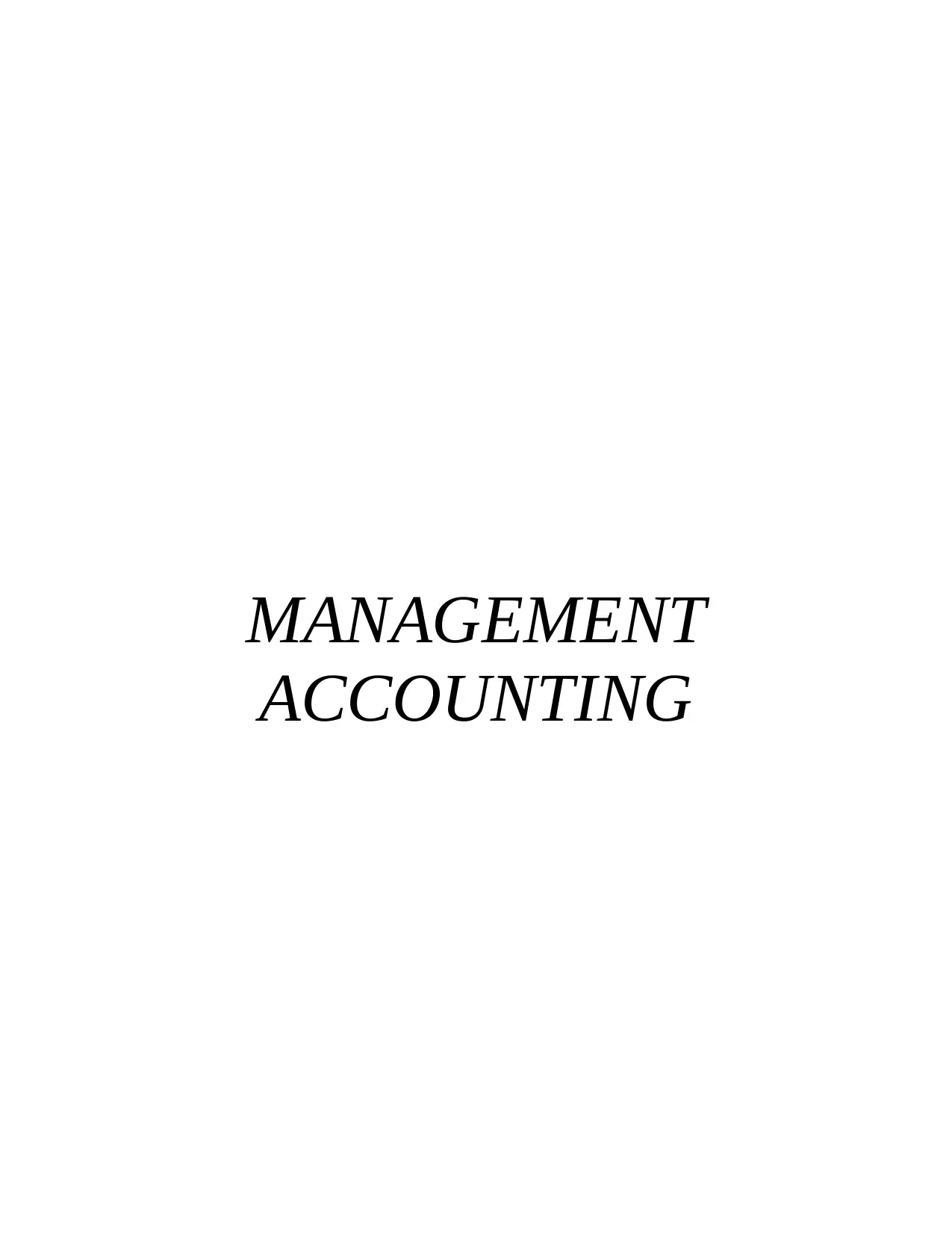
MANAGEMENT
ACCOUNTING
ACCOUNTING
Paraphrase This Document
Need a fresh take? Get an instant paraphrase of this document with our AI Paraphraser
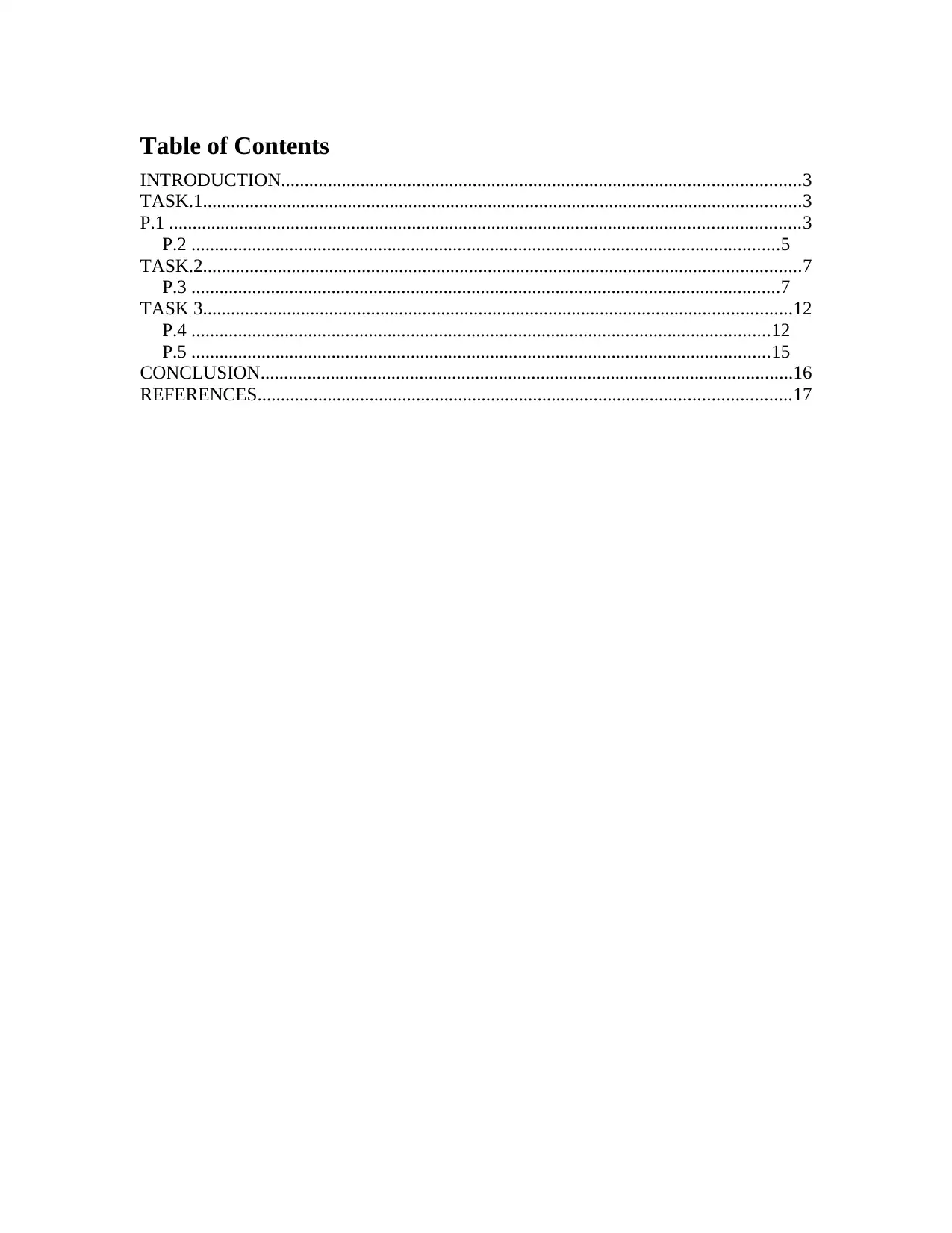
Table of Contents
INTRODUCTION...............................................................................................................3
TASK.1................................................................................................................................3
P.1 .......................................................................................................................................3
P.2 ..............................................................................................................................5
TASK.2................................................................................................................................7
P.3 ..............................................................................................................................7
TASK 3..............................................................................................................................12
P.4 ............................................................................................................................12
P.5 ............................................................................................................................15
CONCLUSION..................................................................................................................16
REFERENCES..................................................................................................................17
INTRODUCTION...............................................................................................................3
TASK.1................................................................................................................................3
P.1 .......................................................................................................................................3
P.2 ..............................................................................................................................5
TASK.2................................................................................................................................7
P.3 ..............................................................................................................................7
TASK 3..............................................................................................................................12
P.4 ............................................................................................................................12
P.5 ............................................................................................................................15
CONCLUSION..................................................................................................................16
REFERENCES..................................................................................................................17

INTRODUCTION
Management accounting is a procedure through which company can report of
administration and financial statements which gives an entire explanation of the
company. All the material data that is essential for the shareholders which can influence
their decisions with respect to a business association are incorporated in the company's
financial statements. These days, it is fundamental to watch out all the data of the
business for sustainable advancement(Renz, 2016). Management Accounting is one the
most vital device by which organization would become acquainted with about the
organization's data and transform those information into sound decision making. A
qualified management accountant is the individual who make the organization to pick
cost leadership procedure in their business, so that an ever increasing number of results
can be allowed by the organization. With the help of management accounting, company
can easily makes an effective and efficient strategy that will also helps to make the
company to survive in the long run and also make the company to have the core
competence in the market.
TASK.1
P.1
Management accounting assist the firm to make the policies fro the attainment of
the pre set goals and objectives(Pipan and Czarniawska, 2010). Management accounting
deals in the inner management of the organization and also assist inner departments to
make the policy fro the effective run. With the help of management accounting,
company would able to make the company's operational process profitable. In the time of
modern era, each organization is deeply concerned in making the company more viable
and this could only be happened with the help of qualified management accountants.
Management accountants are the individuals who know how to run the company so that it
could generate the profits for the firm(Quinn, 2011). Management accountants assist the
the company to do research for the financial and non-financial data, so that the top level
authority can make the strategies or policies for the effective operations of the company.
Management accountants also helps to identify the risk within the organization and
Management accounting is a procedure through which company can report of
administration and financial statements which gives an entire explanation of the
company. All the material data that is essential for the shareholders which can influence
their decisions with respect to a business association are incorporated in the company's
financial statements. These days, it is fundamental to watch out all the data of the
business for sustainable advancement(Renz, 2016). Management Accounting is one the
most vital device by which organization would become acquainted with about the
organization's data and transform those information into sound decision making. A
qualified management accountant is the individual who make the organization to pick
cost leadership procedure in their business, so that an ever increasing number of results
can be allowed by the organization. With the help of management accounting, company
can easily makes an effective and efficient strategy that will also helps to make the
company to survive in the long run and also make the company to have the core
competence in the market.
TASK.1
P.1
Management accounting assist the firm to make the policies fro the attainment of
the pre set goals and objectives(Pipan and Czarniawska, 2010). Management accounting
deals in the inner management of the organization and also assist inner departments to
make the policy fro the effective run. With the help of management accounting,
company would able to make the company's operational process profitable. In the time of
modern era, each organization is deeply concerned in making the company more viable
and this could only be happened with the help of qualified management accountants.
Management accountants are the individuals who know how to run the company so that it
could generate the profits for the firm(Quinn, 2011). Management accountants assist the
the company to do research for the financial and non-financial data, so that the top level
authority can make the strategies or policies for the effective operations of the company.
Management accountants also helps to identify the risk within the organization and
⊘ This is a preview!⊘
Do you want full access?
Subscribe today to unlock all pages.

Trusted by 1+ million students worldwide

makes effective policies to overcome those risks. Managerial accounting makes the
company so eligible so that the company can take the competitive advantage over the
competitors in the relevant market.
However, there are various kinds of management accounting techniques which
are required in the company (Nandan, 2010). Firms today face the issues of how to adjust
their techniques, plans of action, and practices to respond to social and natural difficulties
while making financial achievement and incentive for their shareholders.
The report proposes various ways management accountant can control their
associations towards economical business achievement:
Price optimization system: It is considered as more effective system of
accounting which is used by the company to determine the price which is
applicable for the customer on which they are agree to buy there products.
Costing accounting system: It is related with those costs which incurred during
production process. It is summarized with various costs such as normal,standard
and actual costing.
Inventory accounting system: It is associated with management and controlling
of stock of the company from getting wastage. There are various methods and
techniques which a managers uses in order to maintain the stocks. Some of them
are EOQ and ABC costing.
Job costing system: Under this system, each products are categories as individual
products rather than all products. It is based on timing of product which are
produce by the company during the time period.
There are various requirement which has been required for the different kinds of
management accounting. Some of them are mentioned below:
Traditional management accounting: through this accounting system company can
concentrates the cost by means of job order of techniques of of process costing. Unilever
plc can easily allocate the cost of the product which are linked to the direct labor, direct
material and other overheads which are related to the production of the goods.
Needs of traditional management accounting: job order costing methodology is applied in
the manufacturing sector(Macintosh and Quattrone, 2012).
company so eligible so that the company can take the competitive advantage over the
competitors in the relevant market.
However, there are various kinds of management accounting techniques which
are required in the company (Nandan, 2010). Firms today face the issues of how to adjust
their techniques, plans of action, and practices to respond to social and natural difficulties
while making financial achievement and incentive for their shareholders.
The report proposes various ways management accountant can control their
associations towards economical business achievement:
Price optimization system: It is considered as more effective system of
accounting which is used by the company to determine the price which is
applicable for the customer on which they are agree to buy there products.
Costing accounting system: It is related with those costs which incurred during
production process. It is summarized with various costs such as normal,standard
and actual costing.
Inventory accounting system: It is associated with management and controlling
of stock of the company from getting wastage. There are various methods and
techniques which a managers uses in order to maintain the stocks. Some of them
are EOQ and ABC costing.
Job costing system: Under this system, each products are categories as individual
products rather than all products. It is based on timing of product which are
produce by the company during the time period.
There are various requirement which has been required for the different kinds of
management accounting. Some of them are mentioned below:
Traditional management accounting: through this accounting system company can
concentrates the cost by means of job order of techniques of of process costing. Unilever
plc can easily allocate the cost of the product which are linked to the direct labor, direct
material and other overheads which are related to the production of the goods.
Needs of traditional management accounting: job order costing methodology is applied in
the manufacturing sector(Macintosh and Quattrone, 2012).
Paraphrase This Document
Need a fresh take? Get an instant paraphrase of this document with our AI Paraphraser
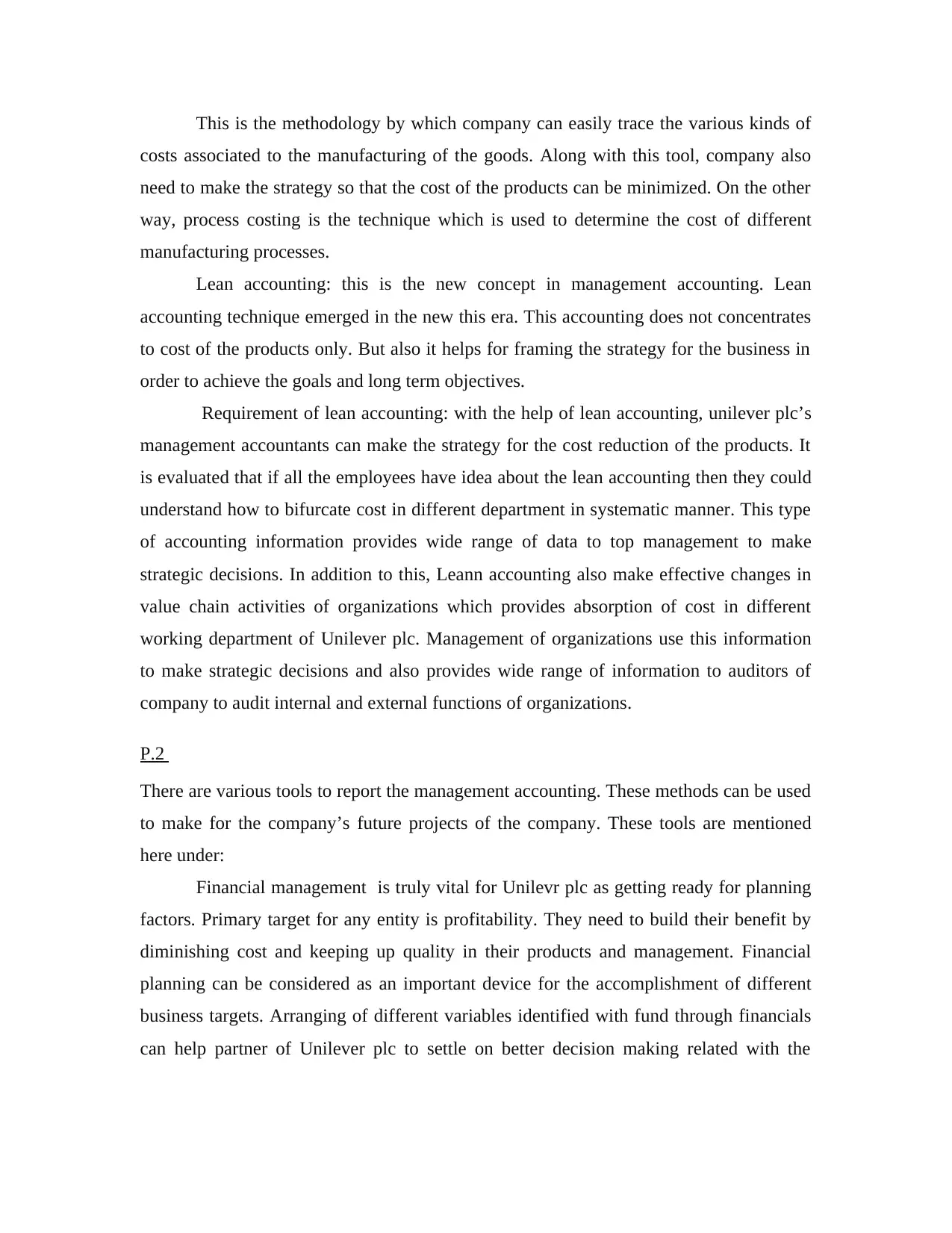
This is the methodology by which company can easily trace the various kinds of
costs associated to the manufacturing of the goods. Along with this tool, company also
need to make the strategy so that the cost of the products can be minimized. On the other
way, process costing is the technique which is used to determine the cost of different
manufacturing processes.
Lean accounting: this is the new concept in management accounting. Lean
accounting technique emerged in the new this era. This accounting does not concentrates
to cost of the products only. But also it helps for framing the strategy for the business in
order to achieve the goals and long term objectives.
Requirement of lean accounting: with the help of lean accounting, unilever plc’s
management accountants can make the strategy for the cost reduction of the products. It
is evaluated that if all the employees have idea about the lean accounting then they could
understand how to bifurcate cost in different department in systematic manner. This type
of accounting information provides wide range of data to top management to make
strategic decisions. In addition to this, Leann accounting also make effective changes in
value chain activities of organizations which provides absorption of cost in different
working department of Unilever plc. Management of organizations use this information
to make strategic decisions and also provides wide range of information to auditors of
company to audit internal and external functions of organizations.
P.2
There are various tools to report the management accounting. These methods can be used
to make for the company’s future projects of the company. These tools are mentioned
here under:
Financial management is truly vital for Unilevr plc as getting ready for planning
factors. Primary target for any entity is profitability. They need to build their benefit by
diminishing cost and keeping up quality in their products and management. Financial
planning can be considered as an important device for the accomplishment of different
business targets. Arranging of different variables identified with fund through financials
can help partner of Unilever plc to settle on better decision making related with the
costs associated to the manufacturing of the goods. Along with this tool, company also
need to make the strategy so that the cost of the products can be minimized. On the other
way, process costing is the technique which is used to determine the cost of different
manufacturing processes.
Lean accounting: this is the new concept in management accounting. Lean
accounting technique emerged in the new this era. This accounting does not concentrates
to cost of the products only. But also it helps for framing the strategy for the business in
order to achieve the goals and long term objectives.
Requirement of lean accounting: with the help of lean accounting, unilever plc’s
management accountants can make the strategy for the cost reduction of the products. It
is evaluated that if all the employees have idea about the lean accounting then they could
understand how to bifurcate cost in different department in systematic manner. This type
of accounting information provides wide range of data to top management to make
strategic decisions. In addition to this, Leann accounting also make effective changes in
value chain activities of organizations which provides absorption of cost in different
working department of Unilever plc. Management of organizations use this information
to make strategic decisions and also provides wide range of information to auditors of
company to audit internal and external functions of organizations.
P.2
There are various tools to report the management accounting. These methods can be used
to make for the company’s future projects of the company. These tools are mentioned
here under:
Financial management is truly vital for Unilevr plc as getting ready for planning
factors. Primary target for any entity is profitability. They need to build their benefit by
diminishing cost and keeping up quality in their products and management. Financial
planning can be considered as an important device for the accomplishment of different
business targets. Arranging of different variables identified with fund through financials
can help partner of Unilever plc to settle on better decision making related with the
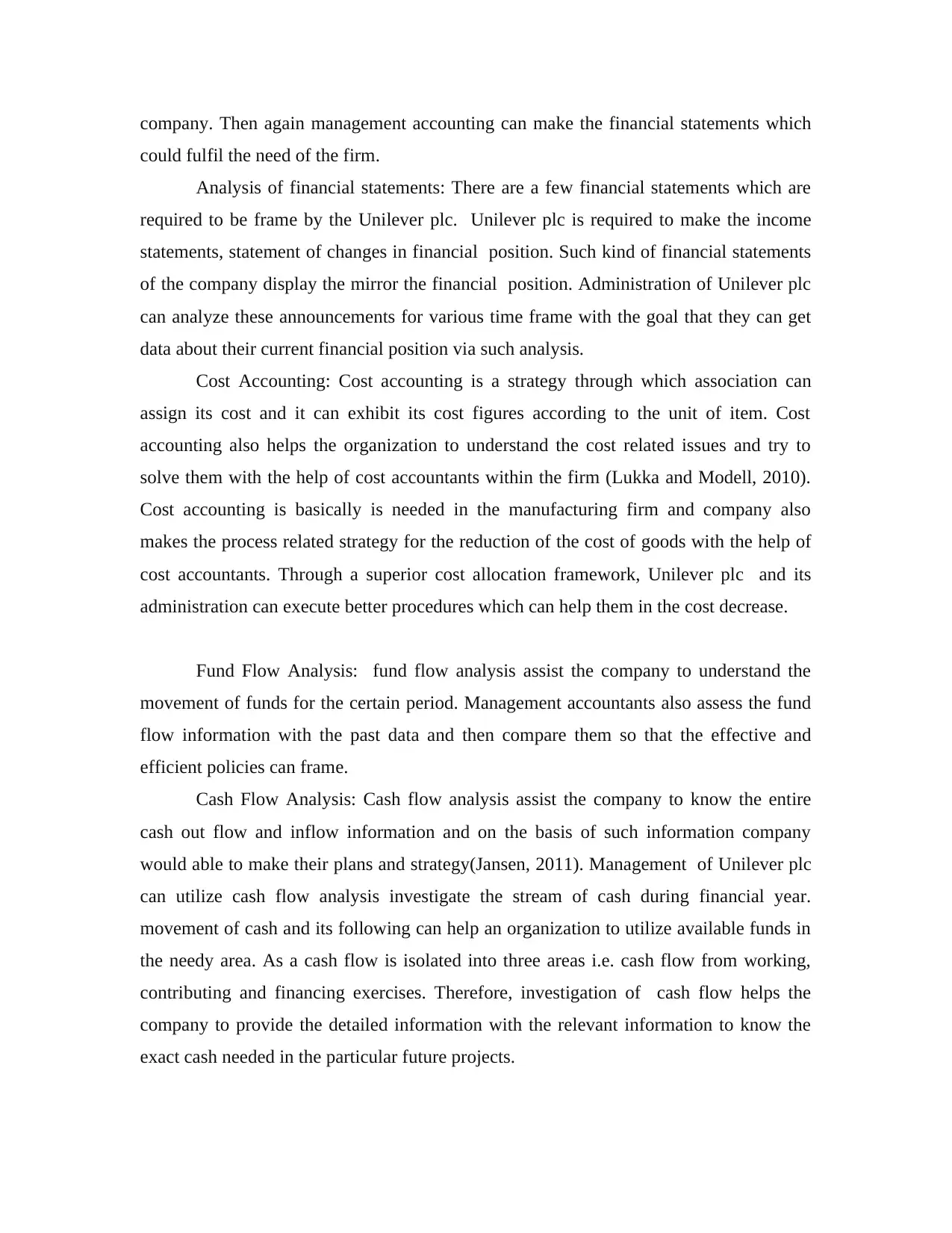
company. Then again management accounting can make the financial statements which
could fulfil the need of the firm.
Analysis of financial statements: There are a few financial statements which are
required to be frame by the Unilever plc. Unilever plc is required to make the income
statements, statement of changes in financial position. Such kind of financial statements
of the company display the mirror the financial position. Administration of Unilever plc
can analyze these announcements for various time frame with the goal that they can get
data about their current financial position via such analysis.
Cost Accounting: Cost accounting is a strategy through which association can
assign its cost and it can exhibit its cost figures according to the unit of item. Cost
accounting also helps the organization to understand the cost related issues and try to
solve them with the help of cost accountants within the firm (Lukka and Modell, 2010).
Cost accounting is basically is needed in the manufacturing firm and company also
makes the process related strategy for the reduction of the cost of goods with the help of
cost accountants. Through a superior cost allocation framework, Unilever plc and its
administration can execute better procedures which can help them in the cost decrease.
Fund Flow Analysis: fund flow analysis assist the company to understand the
movement of funds for the certain period. Management accountants also assess the fund
flow information with the past data and then compare them so that the effective and
efficient policies can frame.
Cash Flow Analysis: Cash flow analysis assist the company to know the entire
cash out flow and inflow information and on the basis of such information company
would able to make their plans and strategy(Jansen, 2011). Management of Unilever plc
can utilize cash flow analysis investigate the stream of cash during financial year.
movement of cash and its following can help an organization to utilize available funds in
the needy area. As a cash flow is isolated into three areas i.e. cash flow from working,
contributing and financing exercises. Therefore, investigation of cash flow helps the
company to provide the detailed information with the relevant information to know the
exact cash needed in the particular future projects.
could fulfil the need of the firm.
Analysis of financial statements: There are a few financial statements which are
required to be frame by the Unilever plc. Unilever plc is required to make the income
statements, statement of changes in financial position. Such kind of financial statements
of the company display the mirror the financial position. Administration of Unilever plc
can analyze these announcements for various time frame with the goal that they can get
data about their current financial position via such analysis.
Cost Accounting: Cost accounting is a strategy through which association can
assign its cost and it can exhibit its cost figures according to the unit of item. Cost
accounting also helps the organization to understand the cost related issues and try to
solve them with the help of cost accountants within the firm (Lukka and Modell, 2010).
Cost accounting is basically is needed in the manufacturing firm and company also
makes the process related strategy for the reduction of the cost of goods with the help of
cost accountants. Through a superior cost allocation framework, Unilever plc and its
administration can execute better procedures which can help them in the cost decrease.
Fund Flow Analysis: fund flow analysis assist the company to understand the
movement of funds for the certain period. Management accountants also assess the fund
flow information with the past data and then compare them so that the effective and
efficient policies can frame.
Cash Flow Analysis: Cash flow analysis assist the company to know the entire
cash out flow and inflow information and on the basis of such information company
would able to make their plans and strategy(Jansen, 2011). Management of Unilever plc
can utilize cash flow analysis investigate the stream of cash during financial year.
movement of cash and its following can help an organization to utilize available funds in
the needy area. As a cash flow is isolated into three areas i.e. cash flow from working,
contributing and financing exercises. Therefore, investigation of cash flow helps the
company to provide the detailed information with the relevant information to know the
exact cash needed in the particular future projects.
⊘ This is a preview!⊘
Do you want full access?
Subscribe today to unlock all pages.

Trusted by 1+ million students worldwide
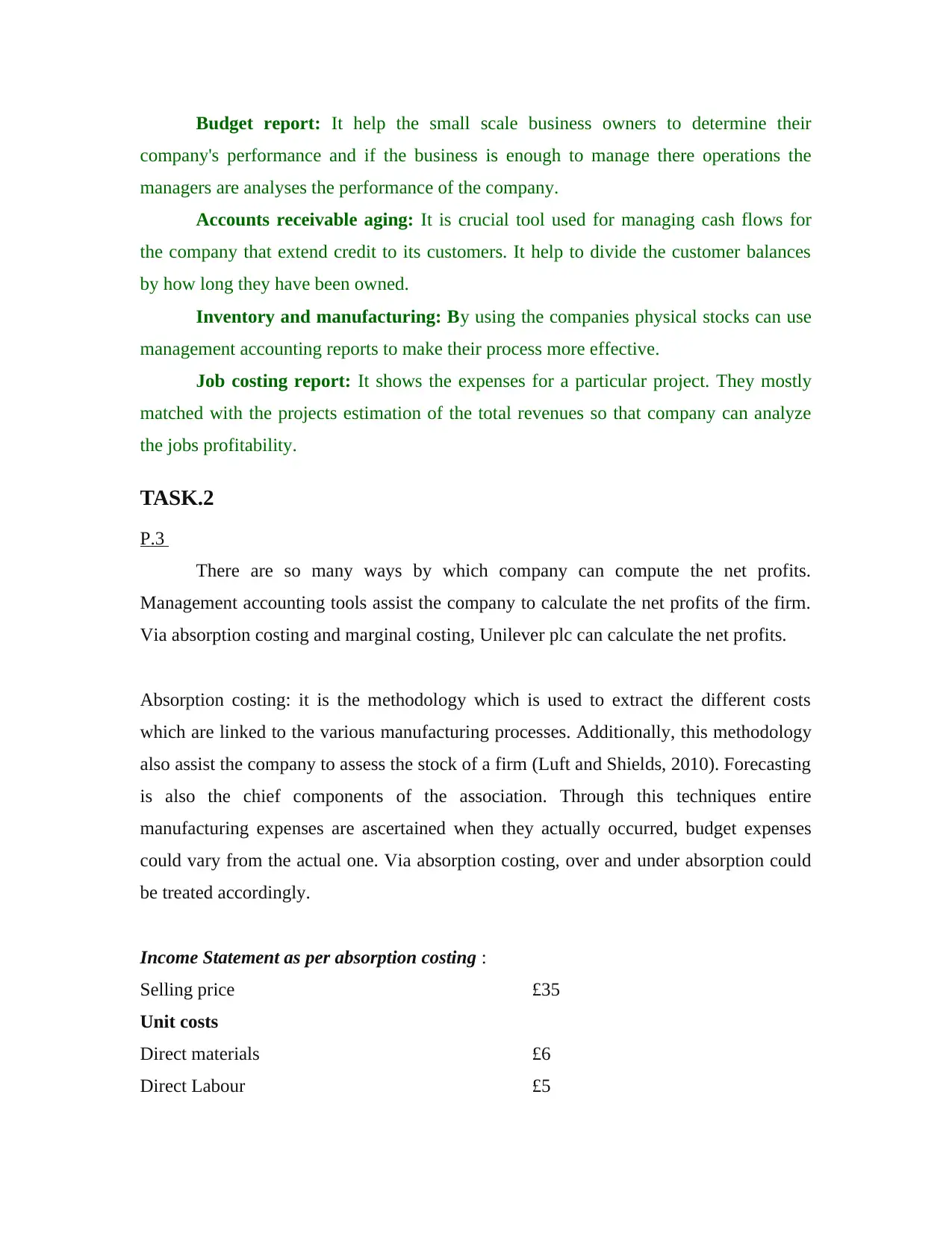
Budget report: It help the small scale business owners to determine their
company's performance and if the business is enough to manage there operations the
managers are analyses the performance of the company.
Accounts receivable aging: It is crucial tool used for managing cash flows for
the company that extend credit to its customers. It help to divide the customer balances
by how long they have been owned.
Inventory and manufacturing: By using the companies physical stocks can use
management accounting reports to make their process more effective.
Job costing report: It shows the expenses for a particular project. They mostly
matched with the projects estimation of the total revenues so that company can analyze
the jobs profitability.
TASK.2
P.3
There are so many ways by which company can compute the net profits.
Management accounting tools assist the company to calculate the net profits of the firm.
Via absorption costing and marginal costing, Unilever plc can calculate the net profits.
Absorption costing: it is the methodology which is used to extract the different costs
which are linked to the various manufacturing processes. Additionally, this methodology
also assist the company to assess the stock of a firm (Luft and Shields, 2010). Forecasting
is also the chief components of the association. Through this techniques entire
manufacturing expenses are ascertained when they actually occurred, budget expenses
could vary from the actual one. Via absorption costing, over and under absorption could
be treated accordingly.
Income Statement as per absorption costing :
Selling price £35
Unit costs
Direct materials £6
Direct Labour £5
company's performance and if the business is enough to manage there operations the
managers are analyses the performance of the company.
Accounts receivable aging: It is crucial tool used for managing cash flows for
the company that extend credit to its customers. It help to divide the customer balances
by how long they have been owned.
Inventory and manufacturing: By using the companies physical stocks can use
management accounting reports to make their process more effective.
Job costing report: It shows the expenses for a particular project. They mostly
matched with the projects estimation of the total revenues so that company can analyze
the jobs profitability.
TASK.2
P.3
There are so many ways by which company can compute the net profits.
Management accounting tools assist the company to calculate the net profits of the firm.
Via absorption costing and marginal costing, Unilever plc can calculate the net profits.
Absorption costing: it is the methodology which is used to extract the different costs
which are linked to the various manufacturing processes. Additionally, this methodology
also assist the company to assess the stock of a firm (Luft and Shields, 2010). Forecasting
is also the chief components of the association. Through this techniques entire
manufacturing expenses are ascertained when they actually occurred, budget expenses
could vary from the actual one. Via absorption costing, over and under absorption could
be treated accordingly.
Income Statement as per absorption costing :
Selling price £35
Unit costs
Direct materials £6
Direct Labour £5
Paraphrase This Document
Need a fresh take? Get an instant paraphrase of this document with our AI Paraphraser

Variable Production overhead £2
Variable sales overhead £1
Budgeted production for the period is 600 units
Fixed costs for the month are given below
Budgeted cost Actual cost
Production overhead £1,800 £2,000
Administration cost £800 £700
Selling cost £400 £600
Absorption costing
Working 1: Calculate full production cost
Direct material £6
Direct labour £5
Variable cost £3
Fixed cost £5
Total £19
Working 2: calculate value of inventory and production
Opening inventory Production Closing inventory
0 700*19 = £13300 100*19 = £1900
Working 3: under/ over absorbed fixed production overhead
Actual fixed production: £3300
Fixed overhead: £3500
Total £200(over absorbed)
Net profit using absorption costing £ £
Sales 21000
(-) Cost of Sales:
Opening inventory 0
Production 13300
Closing inventory (1900) (11400)
Variable sales overhead £1
Budgeted production for the period is 600 units
Fixed costs for the month are given below
Budgeted cost Actual cost
Production overhead £1,800 £2,000
Administration cost £800 £700
Selling cost £400 £600
Absorption costing
Working 1: Calculate full production cost
Direct material £6
Direct labour £5
Variable cost £3
Fixed cost £5
Total £19
Working 2: calculate value of inventory and production
Opening inventory Production Closing inventory
0 700*19 = £13300 100*19 = £1900
Working 3: under/ over absorbed fixed production overhead
Actual fixed production: £3300
Fixed overhead: £3500
Total £200(over absorbed)
Net profit using absorption costing £ £
Sales 21000
(-) Cost of Sales:
Opening inventory 0
Production 13300
Closing inventory (1900) (11400)
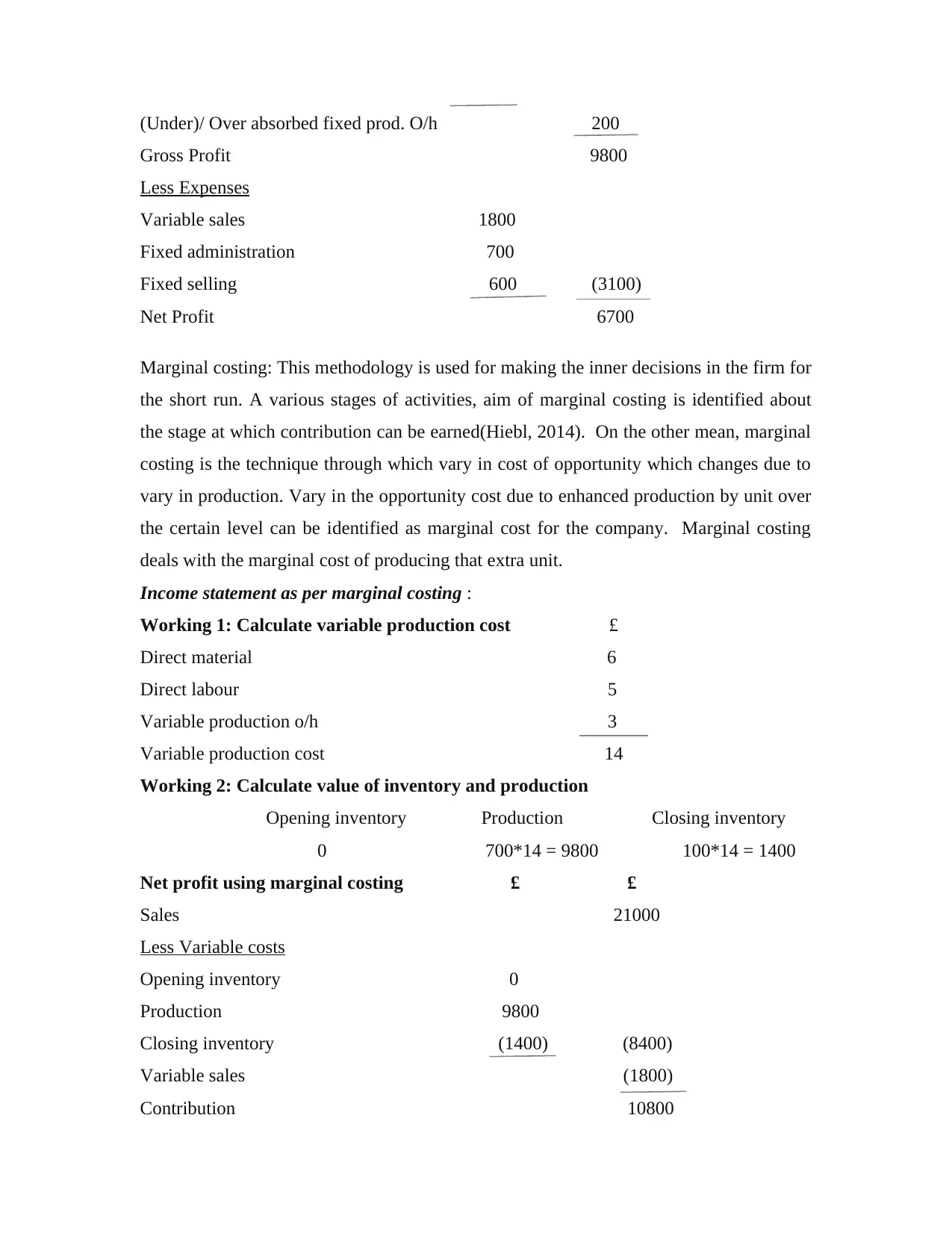
(Under)/ Over absorbed fixed prod. O/h 200
Gross Profit 9800
Less Expenses
Variable sales 1800
Fixed administration 700
Fixed selling 600 (3100)
Net Profit 6700
Marginal costing: This methodology is used for making the inner decisions in the firm for
the short run. A various stages of activities, aim of marginal costing is identified about
the stage at which contribution can be earned(Hiebl, 2014). On the other mean, marginal
costing is the technique through which vary in cost of opportunity which changes due to
vary in production. Vary in the opportunity cost due to enhanced production by unit over
the certain level can be identified as marginal cost for the company. Marginal costing
deals with the marginal cost of producing that extra unit.
Income statement as per marginal costing :
Working 1: Calculate variable production cost £
Direct material 6
Direct labour 5
Variable production o/h 3
Variable production cost 14
Working 2: Calculate value of inventory and production
Opening inventory Production Closing inventory
0 700*14 = 9800 100*14 = 1400
Net profit using marginal costing £ £
Sales 21000
Less Variable costs
Opening inventory 0
Production 9800
Closing inventory (1400) (8400)
Variable sales (1800)
Contribution 10800
Gross Profit 9800
Less Expenses
Variable sales 1800
Fixed administration 700
Fixed selling 600 (3100)
Net Profit 6700
Marginal costing: This methodology is used for making the inner decisions in the firm for
the short run. A various stages of activities, aim of marginal costing is identified about
the stage at which contribution can be earned(Hiebl, 2014). On the other mean, marginal
costing is the technique through which vary in cost of opportunity which changes due to
vary in production. Vary in the opportunity cost due to enhanced production by unit over
the certain level can be identified as marginal cost for the company. Marginal costing
deals with the marginal cost of producing that extra unit.
Income statement as per marginal costing :
Working 1: Calculate variable production cost £
Direct material 6
Direct labour 5
Variable production o/h 3
Variable production cost 14
Working 2: Calculate value of inventory and production
Opening inventory Production Closing inventory
0 700*14 = 9800 100*14 = 1400
Net profit using marginal costing £ £
Sales 21000
Less Variable costs
Opening inventory 0
Production 9800
Closing inventory (1400) (8400)
Variable sales (1800)
Contribution 10800
⊘ This is a preview!⊘
Do you want full access?
Subscribe today to unlock all pages.

Trusted by 1+ million students worldwide

Less Fixed costs
Fixed Production overhead 2000
Administration cost 700
Selling cost 600 3300
Net Profit 7500
Difference between absorption and marginal costing techniques :
Marginal Costing Absorption Costing
In marginal costing, variable costs
linked with production are exclusively
apportioned.
Costs linked with products covers only
variable cost.
In this, overheads are divided into two
categories, i.e. fixed and variable
overheads.
revenue in marginal costing could be
identified via profit-volume ration (PV
Ratio)
In Absorption costing all types
of costs are absorbed on a
certain basis and then that cost
is apportioned to various
products.
Absorption costing assist to
absorbs and allocate both fixed
and variable costs in
production.
Absorption costing bifercates
overheads into three categories,
i.e. production, management
and overheads linked with
selling and distribution.
In absorption costing, net profit
according to income statement
is considered as a profit under
absorption costing.
Utilization of management accounting methods if there should arise an occurrence of
Unilever plc :
Fixed Production overhead 2000
Administration cost 700
Selling cost 600 3300
Net Profit 7500
Difference between absorption and marginal costing techniques :
Marginal Costing Absorption Costing
In marginal costing, variable costs
linked with production are exclusively
apportioned.
Costs linked with products covers only
variable cost.
In this, overheads are divided into two
categories, i.e. fixed and variable
overheads.
revenue in marginal costing could be
identified via profit-volume ration (PV
Ratio)
In Absorption costing all types
of costs are absorbed on a
certain basis and then that cost
is apportioned to various
products.
Absorption costing assist to
absorbs and allocate both fixed
and variable costs in
production.
Absorption costing bifercates
overheads into three categories,
i.e. production, management
and overheads linked with
selling and distribution.
In absorption costing, net profit
according to income statement
is considered as a profit under
absorption costing.
Utilization of management accounting methods if there should arise an occurrence of
Unilever plc :
Paraphrase This Document
Need a fresh take? Get an instant paraphrase of this document with our AI Paraphraser

Unilever plc is a company which has so many employees in its hierarchical
structure. it can be seen that the income of the company is high when contrasted with
different organizations working in a similar segment and performing same operations.
Management accounting and its strategies are used in the firm for better operational
business. They organize with each other in helping management of the Unilever plc for
accomplishment of its destinations and goals. Presently business condition administrative
work forces needs to track for execution of Unilever plc so that they can follow that
business association and its improvement is going in the correct direction and also helps
to attaining the set targets(Herbert and Seal, 2012). There are a few procedures of
management accounting which can be utilized by administration of Unilever plc , these
methods are said beneath :
Cost Volume Profit Analysis(CVP Analysis): Cost volume profit analysis is a
strategy which is utilized by administration of association for deciding the effect of
change in cost of item and its volume on Unilever plc's working income and net income.
Company is required to create an assumption that selling price will stay consistent amid
course of business, assurance of CVP analysis relies on upon the way that cost of
manufacturing is settled amid a given time (Weißenberger and Angelkort, 2011). In given
period actual production overhead, selling cost and administration expense is more than
the planned cost, as aggregate budgeted total cost of these three component was £ 2600
however actual cost is £ 3300.On the other hand Budgeted selection of candidates
through Unilever plc was 600 competitors during a specific era yet the real populace of
enrollment was 700 applicants amid a specific period. Subsequently management
accountant can break down through cost volume profit analysis that how volume of
enlisted applicants impacts the total cost.
Absorption Costing : From the above income statement which is set up according
to strategy for absorption costing all out manufacturing cost per unit of Unilever plc was
£ 19 which incorporates £ 6 for direct material, £ 5 for direct work, £ 3 is for variable
cost and £ 5 reflects to fixed cost allocated on certain basis. As per absorption costing,
structure. it can be seen that the income of the company is high when contrasted with
different organizations working in a similar segment and performing same operations.
Management accounting and its strategies are used in the firm for better operational
business. They organize with each other in helping management of the Unilever plc for
accomplishment of its destinations and goals. Presently business condition administrative
work forces needs to track for execution of Unilever plc so that they can follow that
business association and its improvement is going in the correct direction and also helps
to attaining the set targets(Herbert and Seal, 2012). There are a few procedures of
management accounting which can be utilized by administration of Unilever plc , these
methods are said beneath :
Cost Volume Profit Analysis(CVP Analysis): Cost volume profit analysis is a
strategy which is utilized by administration of association for deciding the effect of
change in cost of item and its volume on Unilever plc's working income and net income.
Company is required to create an assumption that selling price will stay consistent amid
course of business, assurance of CVP analysis relies on upon the way that cost of
manufacturing is settled amid a given time (Weißenberger and Angelkort, 2011). In given
period actual production overhead, selling cost and administration expense is more than
the planned cost, as aggregate budgeted total cost of these three component was £ 2600
however actual cost is £ 3300.On the other hand Budgeted selection of candidates
through Unilever plc was 600 competitors during a specific era yet the real populace of
enrollment was 700 applicants amid a specific period. Subsequently management
accountant can break down through cost volume profit analysis that how volume of
enlisted applicants impacts the total cost.
Absorption Costing : From the above income statement which is set up according
to strategy for absorption costing all out manufacturing cost per unit of Unilever plc was
£ 19 which incorporates £ 6 for direct material, £ 5 for direct work, £ 3 is for variable
cost and £ 5 reflects to fixed cost allocated on certain basis. As per absorption costing,
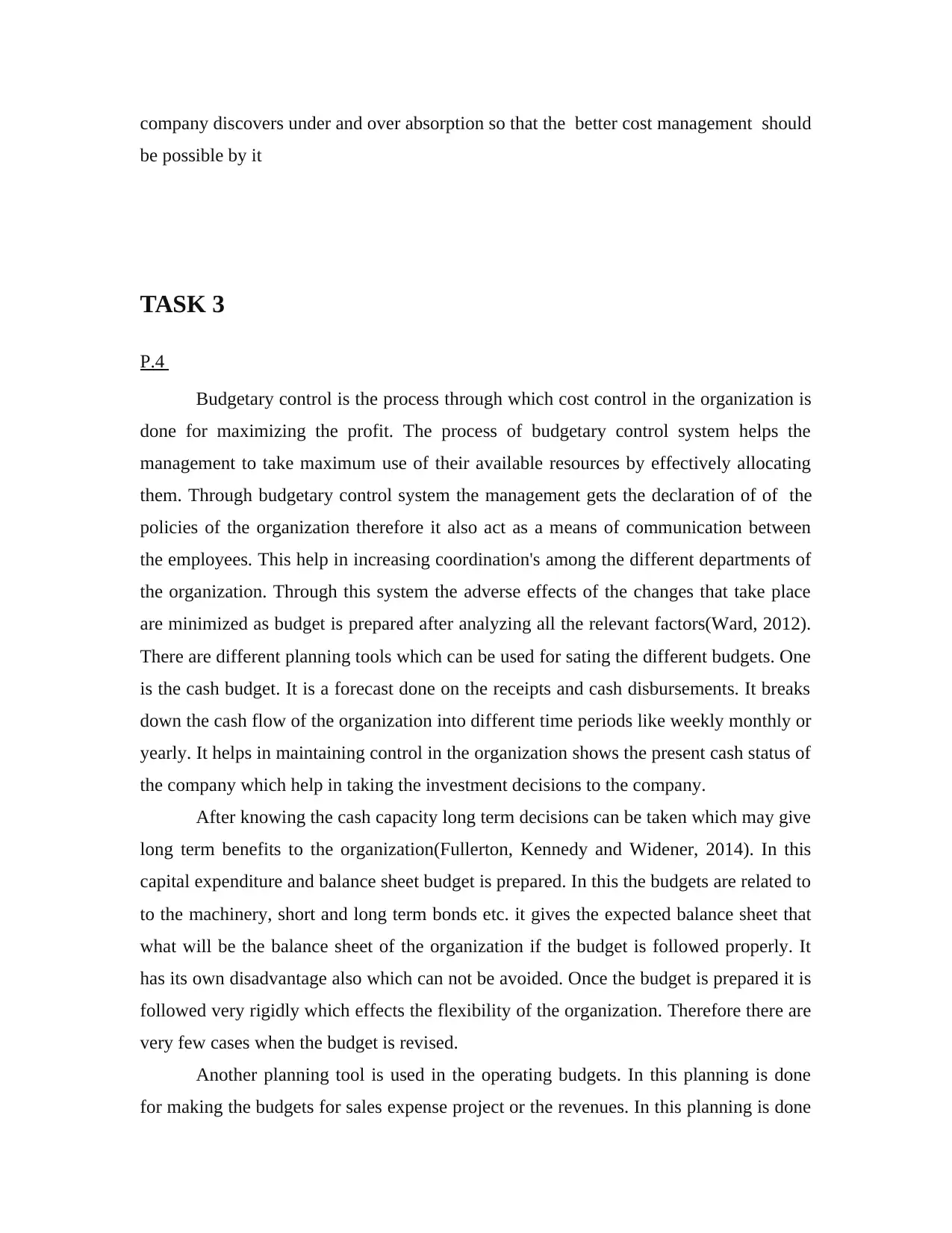
company discovers under and over absorption so that the better cost management should
be possible by it
TASK 3
P.4
Budgetary control is the process through which cost control in the organization is
done for maximizing the profit. The process of budgetary control system helps the
management to take maximum use of their available resources by effectively allocating
them. Through budgetary control system the management gets the declaration of of the
policies of the organization therefore it also act as a means of communication between
the employees. This help in increasing coordination's among the different departments of
the organization. Through this system the adverse effects of the changes that take place
are minimized as budget is prepared after analyzing all the relevant factors(Ward, 2012).
There are different planning tools which can be used for sating the different budgets. One
is the cash budget. It is a forecast done on the receipts and cash disbursements. It breaks
down the cash flow of the organization into different time periods like weekly monthly or
yearly. It helps in maintaining control in the organization shows the present cash status of
the company which help in taking the investment decisions to the company.
After knowing the cash capacity long term decisions can be taken which may give
long term benefits to the organization(Fullerton, Kennedy and Widener, 2014). In this
capital expenditure and balance sheet budget is prepared. In this the budgets are related to
to the machinery, short and long term bonds etc. it gives the expected balance sheet that
what will be the balance sheet of the organization if the budget is followed properly. It
has its own disadvantage also which can not be avoided. Once the budget is prepared it is
followed very rigidly which effects the flexibility of the organization. Therefore there are
very few cases when the budget is revised.
Another planning tool is used in the operating budgets. In this planning is done
for making the budgets for sales expense project or the revenues. In this planning is done
be possible by it
TASK 3
P.4
Budgetary control is the process through which cost control in the organization is
done for maximizing the profit. The process of budgetary control system helps the
management to take maximum use of their available resources by effectively allocating
them. Through budgetary control system the management gets the declaration of of the
policies of the organization therefore it also act as a means of communication between
the employees. This help in increasing coordination's among the different departments of
the organization. Through this system the adverse effects of the changes that take place
are minimized as budget is prepared after analyzing all the relevant factors(Ward, 2012).
There are different planning tools which can be used for sating the different budgets. One
is the cash budget. It is a forecast done on the receipts and cash disbursements. It breaks
down the cash flow of the organization into different time periods like weekly monthly or
yearly. It helps in maintaining control in the organization shows the present cash status of
the company which help in taking the investment decisions to the company.
After knowing the cash capacity long term decisions can be taken which may give
long term benefits to the organization(Fullerton, Kennedy and Widener, 2014). In this
capital expenditure and balance sheet budget is prepared. In this the budgets are related to
to the machinery, short and long term bonds etc. it gives the expected balance sheet that
what will be the balance sheet of the organization if the budget is followed properly. It
has its own disadvantage also which can not be avoided. Once the budget is prepared it is
followed very rigidly which effects the flexibility of the organization. Therefore there are
very few cases when the budget is revised.
Another planning tool is used in the operating budgets. In this planning is done
for making the budgets for sales expense project or the revenues. In this planning is done
⊘ This is a preview!⊘
Do you want full access?
Subscribe today to unlock all pages.

Trusted by 1+ million students worldwide
1 out of 18
Related Documents
Your All-in-One AI-Powered Toolkit for Academic Success.
+13062052269
info@desklib.com
Available 24*7 on WhatsApp / Email
![[object Object]](/_next/static/media/star-bottom.7253800d.svg)
Unlock your academic potential
Copyright © 2020–2025 A2Z Services. All Rights Reserved. Developed and managed by ZUCOL.





